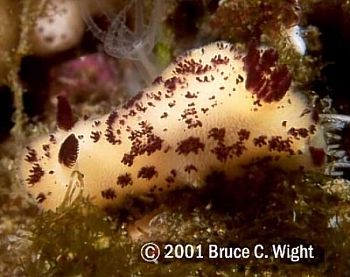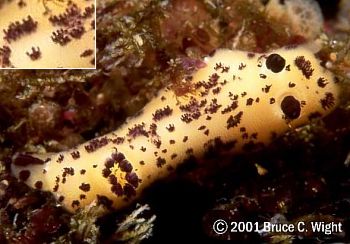

Jorunna pardus
Behrens & Henderson, 1981
Order: NUDIBRANCHIA
Suborder: DORIDINA
Family: Dorididae
DISTRIBUTION
Known from California, USA and Baja California, Mexico.
PHOTO
San Clemente, California, July 1994. Photo: Bruce Wight.
Like all species of Jorunna, the mantle is covered with spiculate papillae called caryophyllidia. The background colour ranges from cream to pale yellow and scattered over the foot and the mantle are brown to black spots and patches of irregular shape and size. On the mantle the spots are formed by aggregations of black or brown caryophyllidia. There is a distinctive large spot on the posterior tip of the foot. The gills are dark brown or black, as are the rhinophore clubs.
This species is very similar in colour to the Japanese J. parva and the widespread Indo-West Pacific unnamed 'species' Jorunna sp.2. However, it is reported to grow to 60mm in length, which is about three times the length of J. parva and Jorunna sp. 2.
Reference:
• Behrens, D.W. & Henderson, R. (1981) Two new cryptobranch dorid nudibranchs from California. The Veliger, 24(2): 120-128.
Rudman, W.B., 2001 (September 10) Jorunna pardus Behrens & Henderson, 1981. [In] Sea Slug Forum. Australian Museum, Sydney. Available from http://www.seaslugforum.net/find/jorupard
Related messages
Re: Jorunna pardus
September 13, 2001
From: Dave Behrens


Dear Bill:
Well Bruce's message beat me to it, but I did want to respond to the Jorunna parva note from Nishina Masayoshi. I must admit that Nishina's Jorunna does look very similar to specimens of Journna pardus from California. Noteworthy also is that Echizen Beach, Japan is a temperate area sharing other species with California waters. Here are two additional photos of our Jorunna pardus from the California Channel Islands.
Please note that Jorunna pardus and J. parva can easily be separated by radular formulae, J. pardus having nearly twice the count of J. parva at:
21-42 x 2.23-30.0.23-30.2.
Dave
Dave@seachallengers.com
Behrens, D. , 2001 (Sep 13) Re: Jorunna pardus. [Message in] Sea Slug Forum. Australian Museum, Sydney. Available from http://www.seaslugforum.net/find/5262Thanks Dave,
The brown colour of the gills also seems to be consistently different, in J. parva only the edge of the gills being brown.
Cheers,
Bill Rudman
Re: Jorunna parva and J. pardus
September 12, 2001
From: Bruce Wight


Dear Bill,
Concerning the discussion Jorunna parva and J. pardus here are photos of a couple of Jorunna pardus. They were taken in July of 1994 at San Clemente, California. I noticed the Forum didn't have any images of them and I wanted to augment the California inventory. The only externally apparent difference between it and Jorunna parva is the coloration of the gills and the rhinophores.
Bruce Wight
bwproductions@earthlink.net
Wight, B., 2001 (Sep 12) Re: Jorunna parva and J. pardus. [Message in] Sea Slug Forum. Australian Museum, Sydney. Available from http://www.seaslugforum.net/find/5250Dear Bruce,
Thanks for these photos. They are a very welcome addition. I can't see much difference in the rhinophores but as you say the whole of the gill structure in J. pardus is a translucent dark brown while in J. parva and Jorunna sp. 2 the gills are translucent white with dark brown edging.
Best wishes,
Bill Rudman
